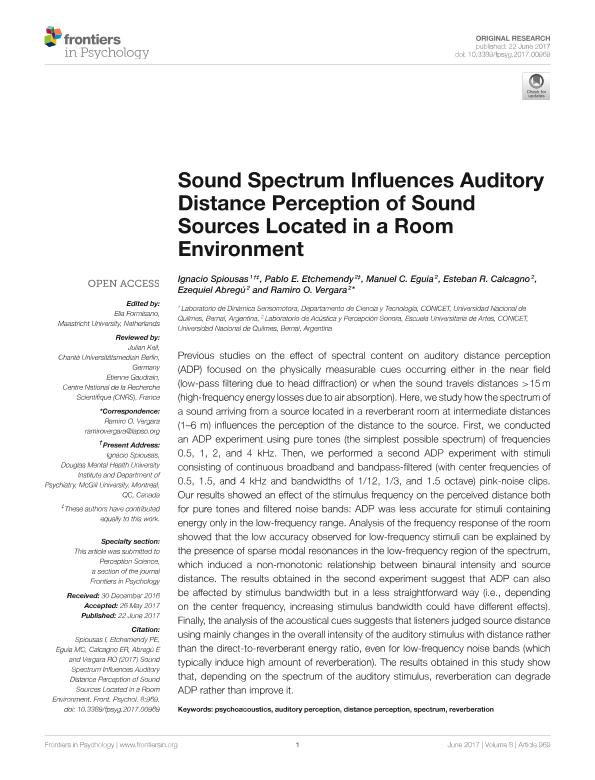Mostrar el registro sencillo del ítem
dc.contributor.author
Spiousas, Ignacio

dc.contributor.author
Etchemendy, Pablo Esteban

dc.contributor.author
Eguia, Manuel Camilo

dc.contributor.author
Calcagno, Esteban

dc.contributor.author
Abregú, Ezequiel Lucas

dc.contributor.author
Vergara, Ramiro Oscar

dc.date.available
2018-04-05T18:58:27Z
dc.date.issued
2017-06
dc.identifier.citation
Spiousas, Ignacio; Etchemendy, Pablo Esteban; Eguia, Manuel Camilo; Calcagno, Esteban; Abregú, Ezequiel Lucas; et al.; Sound spectrum influences auditory distance perception of sound sources located in a room environment; Frontiers; Frontiers in Psychology; 8; JUN; 6-2017; 1-16
dc.identifier.issn
1664-1078
dc.identifier.uri
http://hdl.handle.net/11336/40960
dc.description.abstract
Previous studies on the effect of spectral content on auditory distance perception (ADP) focused on the physically measurable cues occurring either in the near field (low-pass filtering due to head diffraction) or when the sound travels distances greater than 15 m (high-frequency energy losses due to air absorption). Here, we study how the spectrum of a sound arriving from a source located in a reverberant room at intermediate distances (1-6 m) influences the perception of the distance to the source. First, we conducted an ADP experiment using pure tones (the simplest possible spectrum) of frequencies 0.5, 1, 2 and 4 kHz. Then, we performed a second ADP experiment with stimuli consisting of continuous bandpass-filtered (with center frequencies of 0.5, 1.5 and 4 kHz and bandwidths of 1/12, 1/3 and 1.5 octave) and broadband pink-noise clips. Our results showed an effect of the stimulus frequency on the perceived distance both for pure tones and filtered noise bands: ADP was less accurate for stimuli containing energy only in the low-frequency range. Analysis of the frequency response of the room showed that the low accuracy observed for low-frequency stimuli can be explained by the presence of sparse modal resonances in the low-frequency region of the spectrum, which induced a non-monotonic relationship between binaural intensity and source distance. The results obtained in the second experiment suggest that ADP can also be affected by stimulus bandwidth but in a less straightforward way (i.e. depending on the center frequency, increasing stimulus bandwidth could have different effects). Finally, the analysis of the acoustical cues suggests that listeners judged source distance using mainly changes in the overall intensity of the auditory stimulus with distance rather than the direct-to-reverberation energy ratio, even for low-frequency noise bands (which typically induce high amount of reverberation). The results obtained in this study show that, depending on the spectrum of the auditory stimulus, reverberation can degrade auditory distance perception rather than improve it.
dc.format
application/pdf
dc.language.iso
eng
dc.publisher
Frontiers
dc.rights
info:eu-repo/semantics/openAccess
dc.rights.uri
https://creativecommons.org/licenses/by-nc-sa/2.5/ar/
dc.subject
Psychoacoustics
dc.subject
Auditory Perception
dc.subject
Distance Perception
dc.subject
Reverberation
dc.subject
Room Acoustics
dc.subject.classification
Psicología

dc.subject.classification
Psicología

dc.subject.classification
CIENCIAS SOCIALES

dc.title
Sound spectrum influences auditory distance perception of sound sources located in a room environment
dc.type
info:eu-repo/semantics/article
dc.type
info:ar-repo/semantics/artículo
dc.type
info:eu-repo/semantics/publishedVersion
dc.date.updated
2018-04-05T13:45:35Z
dc.journal.volume
8
dc.journal.number
JUN
dc.journal.pagination
1-16
dc.journal.pais
Suiza

dc.journal.ciudad
Lausanne
dc.description.fil
Fil: Spiousas, Ignacio. Universidad Nacional de Quilmes. Departamento de Ciencia y Tecnología; Argentina. Consejo Nacional de Investigaciones Científicas y Técnicas; Argentina
dc.description.fil
Fil: Etchemendy, Pablo Esteban. Universidad Nacional de Quilmes. Departamento de Ciencia y Tecnología. Laboratorio de Acústica y Percepción Sonora; Argentina. Consejo Nacional de Investigaciones Científicas y Técnicas; Argentina
dc.description.fil
Fil: Eguia, Manuel Camilo. Universidad Nacional de Quilmes. Departamento de Ciencia y Tecnología. Laboratorio de Acústica y Percepción Sonora; Argentina. Consejo Nacional de Investigaciones Científicas y Técnicas; Argentina
dc.description.fil
Fil: Calcagno, Esteban. Universidad Nacional de Quilmes. Departamento de Ciencia y Tecnología. Laboratorio de Acústica y Percepción Sonora; Argentina. Consejo Nacional de Investigaciones Científicas y Técnicas; Argentina
dc.description.fil
Fil: Abregú, Ezequiel Lucas. Universidad Nacional de Quilmes. Departamento de Ciencia y Tecnología. Laboratorio de Acústica y Percepción Sonora; Argentina. Consejo Nacional de Investigaciones Científicas y Técnicas; Argentina
dc.description.fil
Fil: Vergara, Ramiro Oscar. Universidad Nacional de Quilmes. Departamento de Ciencia y Tecnología. Laboratorio de Acústica y Percepción Sonora; Argentina. Consejo Nacional de Investigaciones Científicas y Técnicas; Argentina
dc.journal.title
Frontiers in Psychology
dc.relation.alternativeid
info:eu-repo/semantics/altIdentifier/doi/http://dx.doi.org/10.3389/fpsyg.2017.00969
dc.relation.alternativeid
info:eu-repo/semantics/altIdentifier/url/https://www.frontiersin.org/articles/10.3389/fpsyg.2017.00969/full
Archivos asociados
